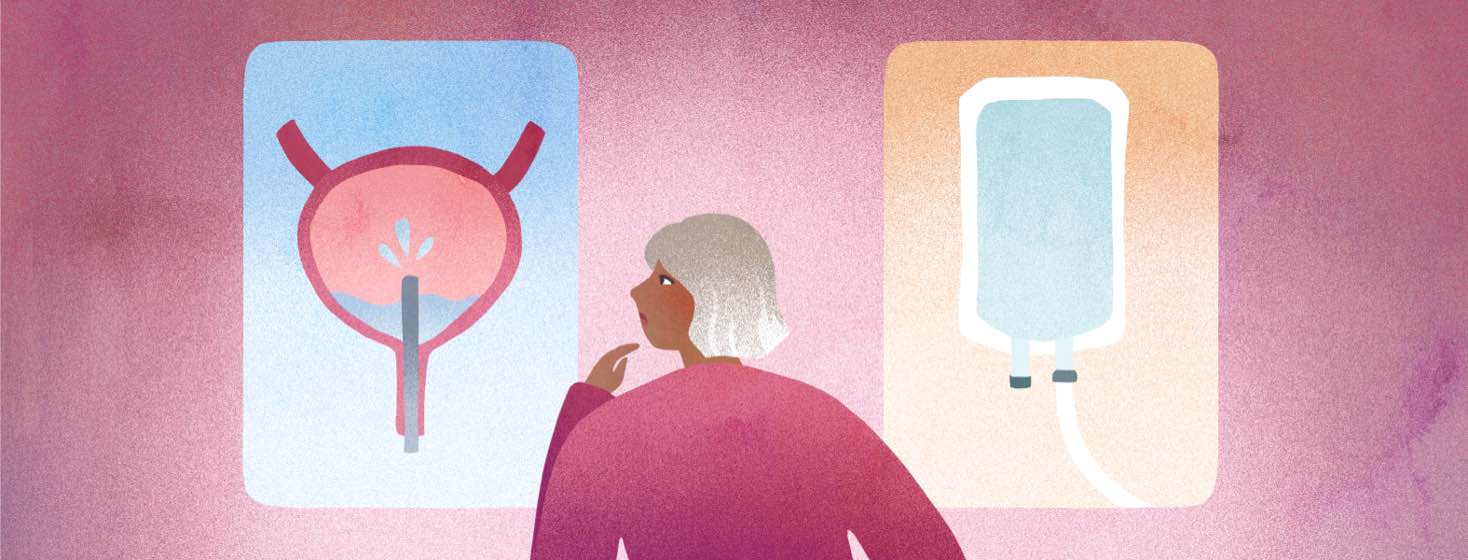BCG or Gemcitabine for Bladder Cancer: When Should They Be Used?
In 1976, Bacillus Calmette-Guérin (BCG) became known as an effective treatment for non-muscle invasive bladder cancer (NMIBC). Since then, BCG has been used throughout the world for preventing NIMBC. Tice® BCG is the brand name, though most people simply refer to this treatment as BCG.1
After transurethral resection surgery (TURBT), placing BCG inside the bladder prevents NMIBC from getting worse. BCG also prevents tumors from coming back once they are removed. This process is called intravesical treatment.2,3
In the last decade, issues with BCG availability have led to the use of other treatments, such as intravesical gemcitabine. Gemzar® (gemcitabine) is also used when BCG no longer works or when it is not tolerated.4
What is BCG?
BCG is an immunotherapy treatment that is most often used to treat people with early-stage bladder cancer (stages 0 or I). BCG is made from live bacteria. It is delivered to the bladder through a catheter, which causes your body to develop an immune response. This allows your immune system to fight cancer cells in the lining of the bladder.5
What is gemcitabine?
Gemcitabine is a chemotherapy drug that is commonly used to treat bladder cancer. It may be given alone or along with cisplatin, another chemotherapy drug. Gemcitabine prevents cancer cells from using DNA properly. Without the use of DNA, cancer cells can no longer grow and live. This stops or prevents bladder cancer from coming back or progressing.6
Which works best?
A 2020 study compared 7 drugs used to prevent non-muscle invasive bladder cancer (NMIBC), including BCG and gemcitabine. Researchers found that BCG and gemcitabine are 2 of the best options to reduce the chance of NMIBC returning after surgery. However, the study showed BCG worked better than gemcitabine for people with high-risk disease.2
Another study looked at the records of people with bladder cancer in Australia from 2010 to 2015. It showed people had similar results when using intravesical BCG or gemcitabine to prevent NMIBC. The people received either drug once a week for 6 weeks. Fewer people who received gemcitabine stopped their treatment because of side effects than with BCG therapy.4
According to the American Urological Association, people with low-risk NMIBC should not receive BCG. Gemcitabine may be given as a single intravesical treatment within 24 hours after surgery if you have low-risk NMIBC. For intermediate-risk, you may benefit from BCG or chemotherapy.3,7
People with high-risk NMIBC are the best candidates for BCG. You will generally be given BCG once a week for 6 weeks for high-risk NMIBC. Together, you and your doctor can decide which treatment may be best for you.3,7
In some cases, you may continue BCG as maintenance treatment. This means you will receive treatment for months or sometimes a year or more. The decision to begin maintenance treatment varies, and not everyone will continue after initial use.3
Do both treatments have the same side effects?
You can have side effects with either BCG or gemcitabine. However, research shows that problems after gemcitabine are less severe than with BCG. BCG treatments may be especially difficult for older people or people with poor immune systems.4
BCG contains live bacteria. About 60 percent of people who receive BCG have bladder irritation or pain with urination. Some people have bladder infections, high fevers, or flu-like symptoms. If you have more than 1 treatment, you are at higher risks of side effects.2-5
Gemcitabine has few side effects as intravesical treatment. Side effects, such as bladder irritation or lower urinary tract irritation, may occur. Rarely, you could have dermatitis, nausea, or vomiting.2-4
BCG shortages
The drug supplier Merck provides the strain of BCG approved for use in the United States. In 2012, Merck became the only supplier of this specific form of BCG.8
BCG is hard to produce. Technicians make it from live bacteria that need to grow slowly. Over time, the demand to make enough drug has caused BCG shortages in the United States. To address this issue, Merck limits the amount of drug shipped throughout the country. In late 2020, Merck announced it is building a new manufacturing facility that will allow it to triple the production of BCG. However, the facility will take 5 to 6 years to build.8,9
Things to consider
In cases of high-risk NMIBC, there is a 60 to 70 percent chance the cancer might return after tumors are removed. There is also up to a 45 percent risk of NMIBC becoming more severe or spreading.2-4
There are several factors that can impact your treatment for NMIBC. If you have questions about why one treatment may be recommended over another, talk to your doctor to discuss your diagnosis and which treatment may work best for you.

Join the conversation